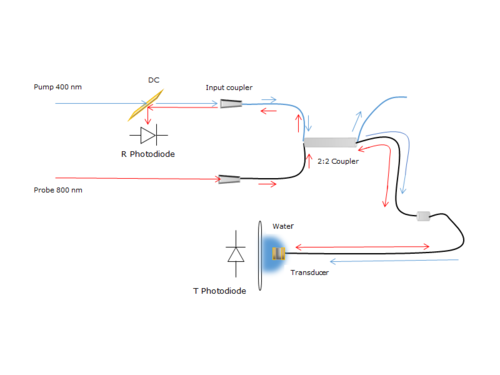Fibre optical LU
Contents
Motivation
In so many circumstances from medical fields to research and engineering, a very small device is needed to observe or monitor targets that are hard to access externally. Using technology developed for ultrasonic cell imaging [1] makes it possible to produce extremely small transducers, smaller than a grain of salt, which can be mounted at the end of optical fibres. Such small transducers have many potential applications in medicine and industry, such as measuring tissue properties during needle biopsies, ultrasonic guiding of needles during injections or investigating the coating properties through very small (sub mm) access very narrow spaces.
In this study we present small opto-acosutic transducers fabricated on the tip of an optical fibre. The aim is to produce a tuneable transducers for producing a wide range of frequency from low to high based on applications. The transducer developed in this study operates in a manner similar to a Fabry-Perot interferometer [2]. This technique was used only as a pure detection where we use the device for both generation and detection of acoustic waves as shown in figure (1).
Experiment concept
Fabry-Perot interferometer technique was used only as a pure detection where we use the device for both generation and detection of acoustic waves. In this study, a pump-probe picosecond ultrasound system is used to generate and detect ultrasound in different frequency regions. The transducers strongly absorb at wavelength of pump and making them efficient thermoplastic generators of elastic waves and strongly reflect at a second wavelength of probe.
Experimental setup
Optical and Mechanical operation
When the probe beam incident on the transducer, a part of beam is transmitted into the cavity and is resonantly reflected (and transmitted) by the structure. Also the transducer absorbs some light that leads into localized heating. The choice of materials, optical wavelengths and thickness of each layer in the structure are the key factors to produce a transducer that is both an efficient thermoelastic generator and sensitive detector. The Fresnel reflection coefficient is used to calculated the sensitivity of the structure at probe wavelength. The figure shows a plot of the sensitivity of a gold:ITO:gold structure as a function of metal and ITO thickness at probe wavelength. The optical modelling of the transducer assumes the structure is of infinite width but is a fair approximation provide the width is grater than the optical wavelength.
Fabrication of the transducer
The devices are comprised of a sandwich structure of partially transparent metal around and optically transparent filling. In this study the transducer consist of gold metal outer layers and a filling of indium-tin oxide (ITO) as dielectric. A direct stutterer coater was used to deposit the layers. The thickness of each layer was calculated using a conventional film thickness monitor during fabrication.The devices operate in manner similar to that of a zero order Fabry-Perot interferometer.
Testing of the device
The preliminary results was collected from a picosecond ultrasound experiment using a Au:ITO:Au 30:120:30 nm transducer in reflection. The Fourier transform where the component detected are clearly visible. The transducer resonance happened around 10 GHz and signal around 5 GHz shows the acoustic wave left the transducer and entered into water. There is also signal around 22 GHz from the substrate.
